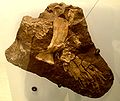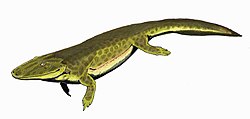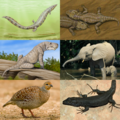Polydactyly in stem-tetrapods should here be understood as having more than five digits to the finger or foot, a condition that was the natural state...
9 KB (993 words) - 12:15, 6 September 2024
be stem tetrapods. Stem tetrapods are members of Tetrapodomorpha, the total group and clade that also includes their descendants, the crown tetrapods: The...
6 KB (535 words) - 11:47, 23 May 2025
"smooth") + ἀμφίβια (amphíbia), meaning "smooth amphibians") is a group of tetrapods that includes all modern amphibians. Lissamphibians consist of three living...
14 KB (1,342 words) - 11:10, 25 May 2025
Acanthostega (category Fossil taxa described in 1952)
"roof", is an extinct genus of stem-tetrapod, among the first vertebrate animals to have recognizable limbs. It appeared in the late Devonian period (Famennian...
13 KB (1,386 words) - 08:32, 25 May 2025
evolution of tetrapods began about 400 million years ago in the Devonian Period with the earliest tetrapods evolved from lobe-finned fishes. Tetrapods (under...
67 KB (7,969 words) - 17:14, 23 May 2025
of early stem tetrapods. Baphetids were among the first of the Carboniferous fossil tetrapods to be found and were originally described in 1850 by John...
6 KB (677 words) - 20:33, 30 March 2025
Dactyly (section Polydactyly)
challenged by Stephen Jay Gould in his 1991 essay "Eight (or Fewer) Little Piggies," where he pointed out polydactyly in early tetrapods and described the specializations...
17 KB (1,938 words) - 23:44, 28 March 2025
Labyrinthodontia (section The labyrinthodonts in life)
exclusive of other tetrapods. Instead, they consistute an evolutionary grade (a paraphyletic group), ancestral to living tetrapods such as lissamphibians...
68 KB (7,503 words) - 03:28, 26 May 2025
tetrapods considered more closely related to amniotes are put in the superorder Reptiliomorpha. The phylogenetic relationships of Paleozoic tetrapods...
8 KB (897 words) - 18:21, 17 April 2025
Eusthenopteron (category Fossil taxa described in 1881)
including tetrapods. It also had labyrinthodont teeth, characterized by infolded enamel, which characterizes all of the earliest known tetrapods as well...
15 KB (1,274 words) - 10:49, 24 May 2025
Ichthyostega (category Evolution of tetrapods)
in swamps. Although Ichthyostega is often labelled a 'tetrapod' because of its limbs and fingers, it evolved long before true crown group tetrapods and...
17 KB (1,420 words) - 13:33, 23 May 2025
and other lobe-finned fishes, and even tetrapods, because all tetrapods at this time still had to lay their eggs in water. Johanson, Z.; Jeffery, J.; Challands...
7 KB (642 words) - 20:29, 30 March 2025
(stem-group tetrapods) that lived in the Carboniferous period. They possessed a variety of characteristics from different tetrapod or stem-tetrapod groups...
7 KB (579 words) - 20:32, 30 March 2025
Ahlberg, P. E.; Johanson, Z. (1998). "Osteolepiforms and the ancestry of tetrapods" (PDF). Nature. 395 (6704): 792–794. Bibcode:1998Natur.395..792A. doi:10...
6 KB (238 words) - 20:09, 16 May 2024
Panderichthys (category Fossil taxa described in 1941)
tetrapods, Panderichthys exhibits a range of features transitional between tristichopterid lobe-fin fishes (e.g., Eusthenopteron) and early tetrapods...
22 KB (2,824 words) - 17:34, 8 May 2025
of the Devonian tetrapod Tulerpeton curtum Lebedev Stegocephalians: Tetrapods and other digit-bearing vertebrates Famennian Tetrapods Worldwide Tulerpeton...
9 KB (1,084 words) - 03:15, 29 April 2025
closest relative of tetrapods known to have retained paired fins rather than feet). Under this use, the number of known Devonian tetrapods have increased dramatically...
11 KB (1,211 words) - 16:04, 20 May 2025
prehistoric lobe-finned fishes, it was cladistically redefined to include tetrapods. A rise in global oxygen content allowed for the evolution of large, predatory...
14 KB (1,110 words) - 04:55, 31 March 2025
consisting of tetrapods (four-limbed vertebrates) and their closest sarcopterygian relatives that are more closely related to living tetrapods than to living...
17 KB (724 words) - 04:54, 31 March 2025
Zachelmie trackways (category Evolution of tetrapods)
relative to tetrapods: Their phylogenetic position remains unchanged and the footprints found in the Holy Cross Mountains are attributed to tetrapods but as...
22 KB (2,117 words) - 06:39, 25 May 2025
forming anchoring points for the ribs. This form of complex backbone was found in some crossopterygian fish, the Ichthyostegalia, most Temnospondyli and some...
1 KB (137 words) - 04:57, 31 March 2025
Hynerpeton (category Fossil taxa described in 1994)
neontological definition of tetrapods (i.e., only in the context of modern life), alternative terms for non-crown tetrapods include "stem-tetrapod" or "stegocephalian"...
30 KB (3,377 words) - 12:35, 23 May 2025
suggested that adelospondyls are stem-tetrapods close to colosteids and a 2017 paper on Lethiscus has Aïstopoda in the tetrapod stem based on their primitive...
21 KB (1,652 words) - 16:30, 17 April 2025
Gaiasia (category Fossil taxa described in 2024)
digit-bearing stem-tetrapods (early amphibians, in the broad sense). It was a close relative to the colosteids, a family of aquatic stem-tetrapods with long...
8 KB (940 words) - 10:30, 30 May 2025
crown-group and stem-group tetrapods. Laurin's Stegocephali is roughly defined as including all vertebrates closer to modern tetrapods than to Panderichthys...
15 KB (989 words) - 04:56, 31 March 2025
Tiktaalik (category Evolution of tetrapods)
closer to tetrapods. Elpistostegalian fish have few unique traits which are not retained from earlier fish or inherited by later tetrapods. In response...
58 KB (5,994 words) - 12:50, 22 May 2025
Embolomeri is an order of tetrapods or stem-tetrapods, possibly members of Reptiliomorpha. Embolomeres first evolved in the Early Carboniferous (Mississippian)...
17 KB (1,033 words) - 20:31, 30 March 2025
that the neurocranium of Palaeospondylus was similar to those of the stem-tetrapods Eusthenopteron and Panderichthys, and concluded that Palaeospondylus...
6 KB (507 words) - 00:18, 25 May 2025
"reptiliomorphs", is also occasionally used to refer to stem-amniotes, i.e. a grade of reptile-like tetrapods that are more closely related to amniotes than they...
29 KB (3,061 words) - 04:03, 19 May 2025
Rhizodus (category Fossil taxa described in 1840)
finned tetrapodomorphs (the group of sarcopterygians that contains modern tetrapods and their extinct relatives). It belonged to Rhizodontida, one of the...
10 KB (997 words) - 01:14, 26 May 2025





























